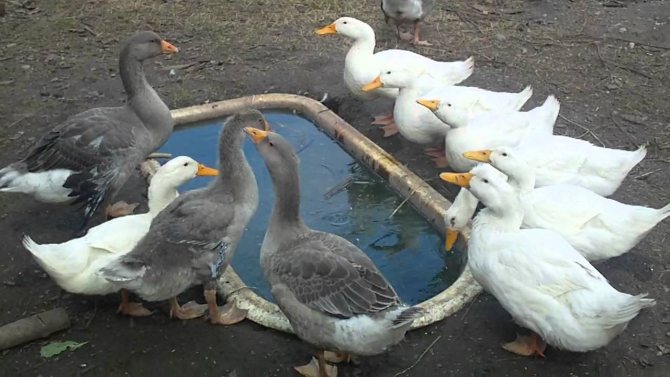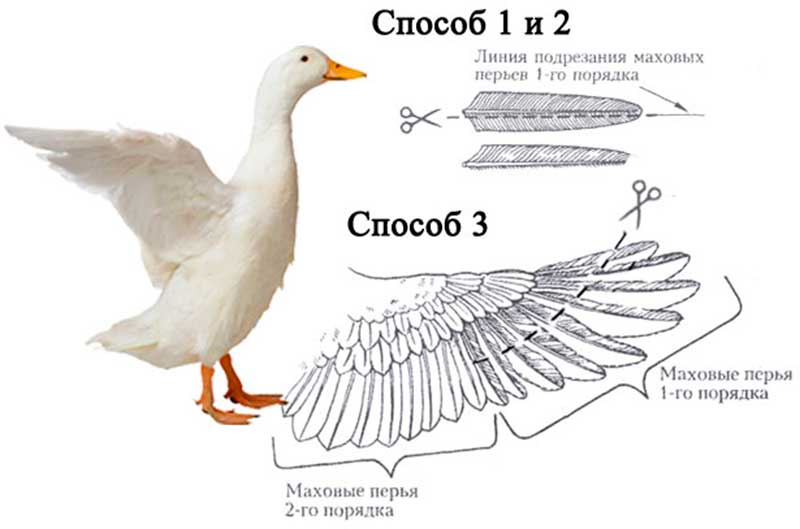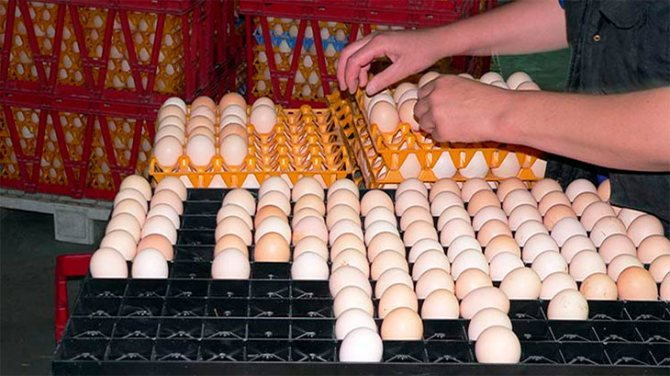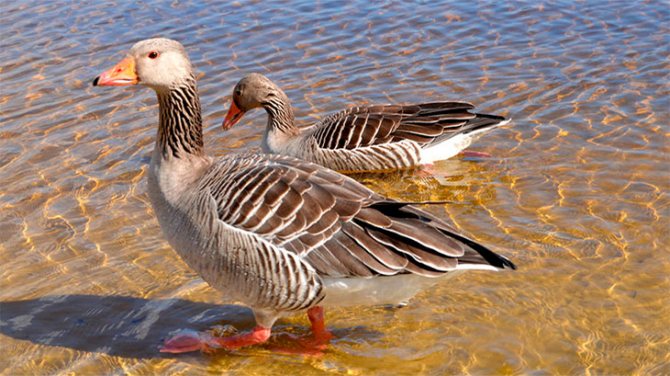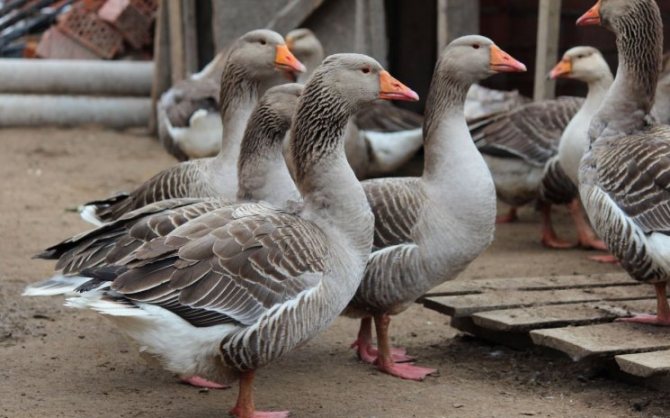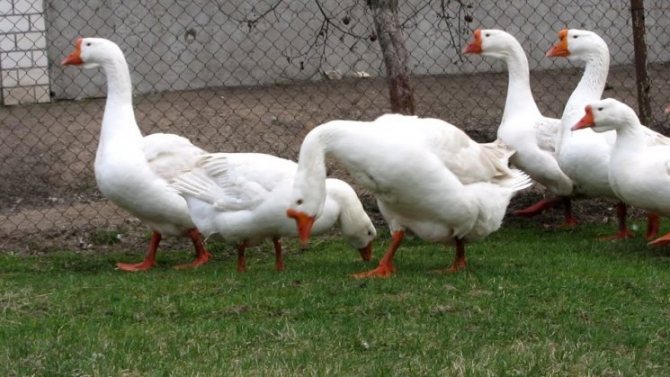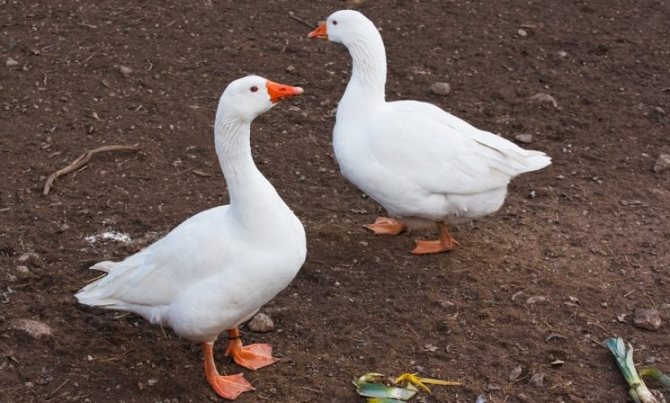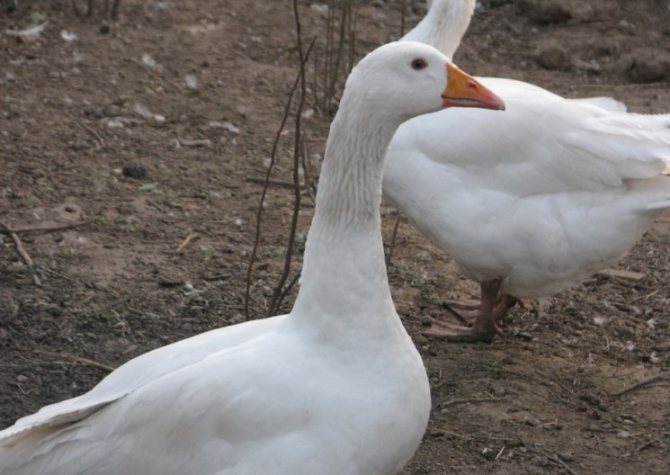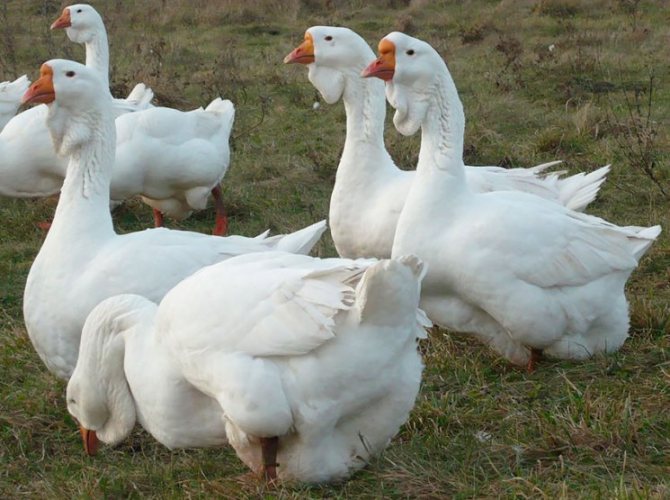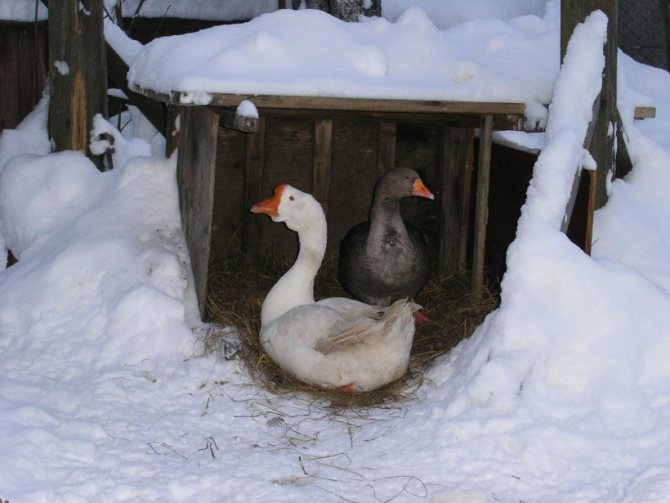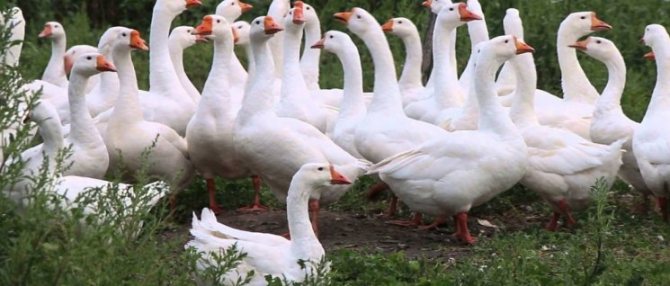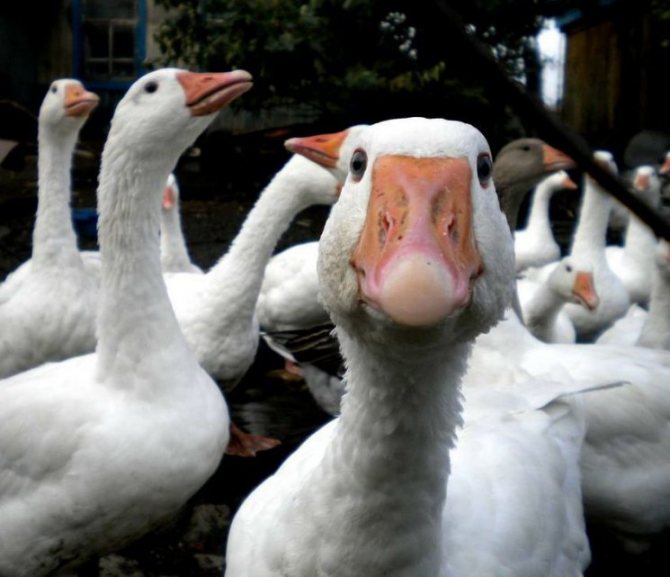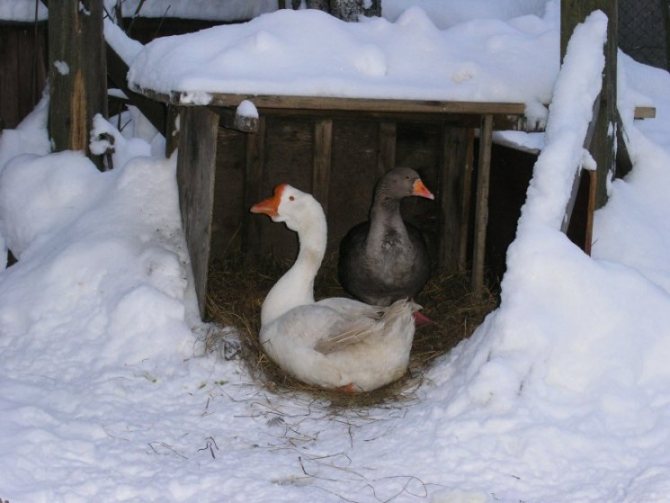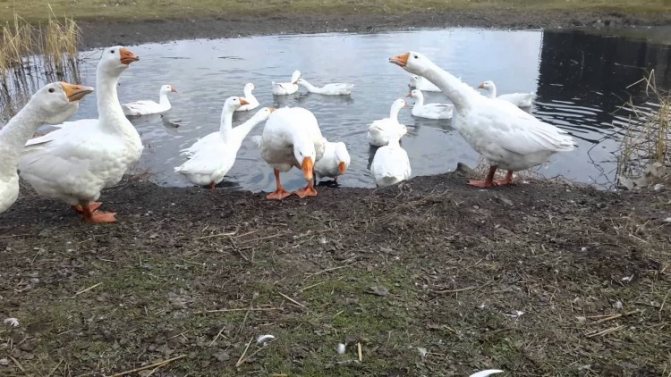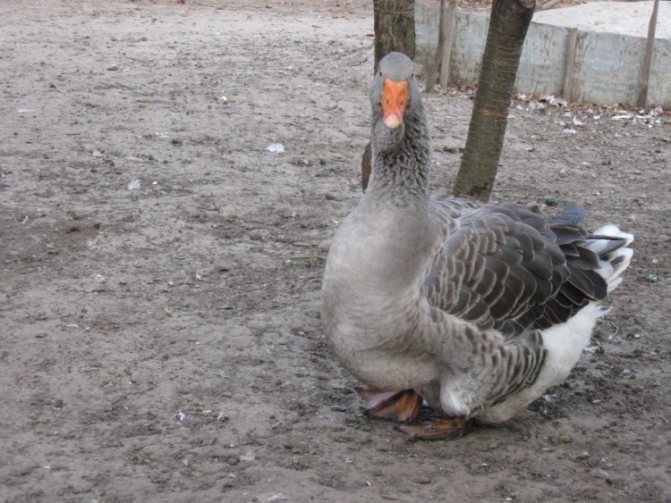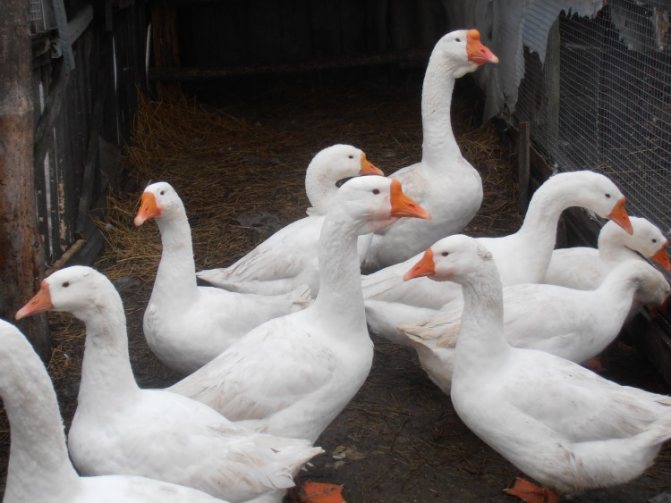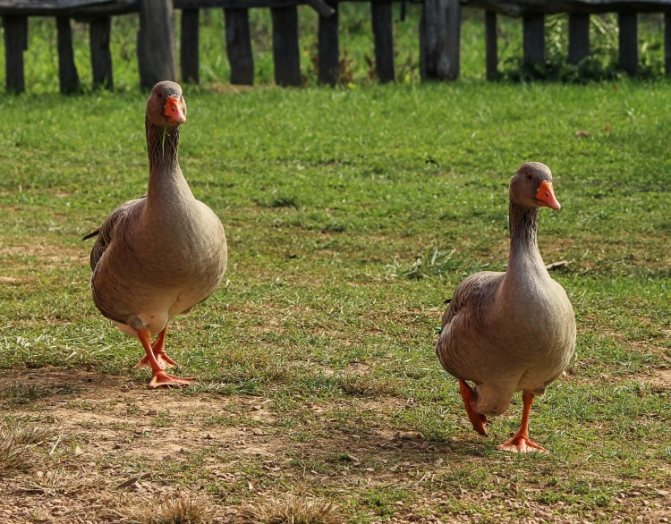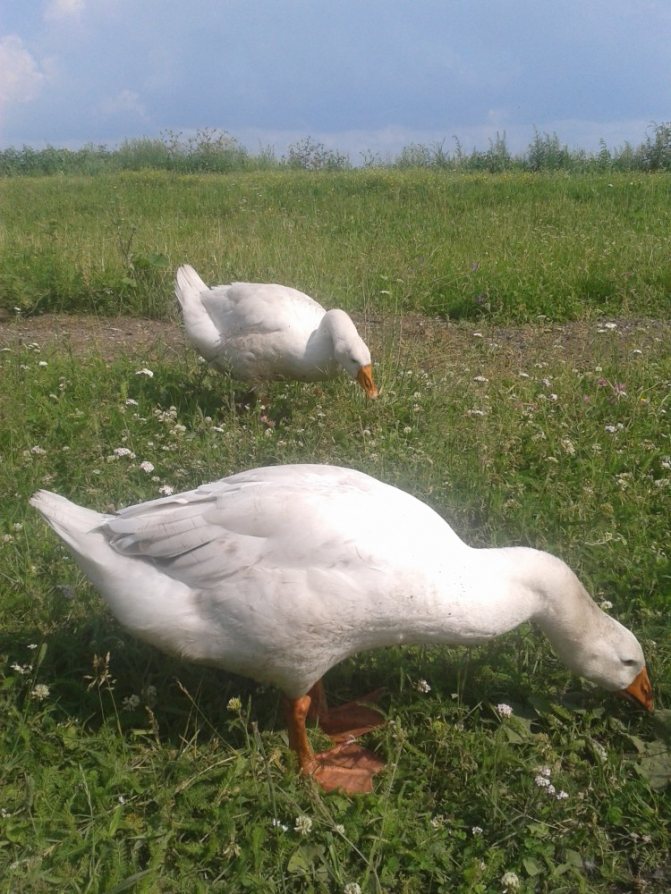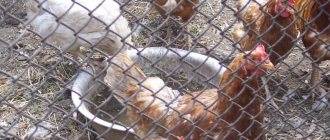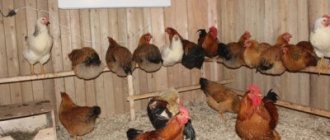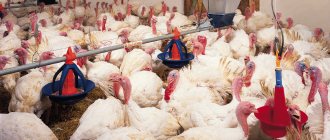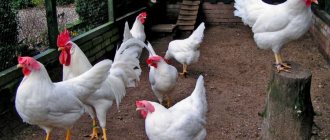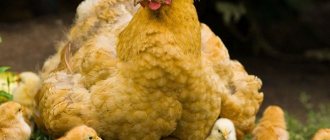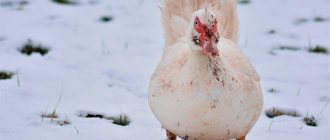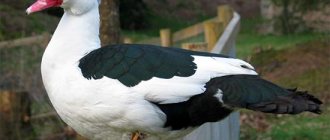How to raise chicks with a brood hen?
It is believed that hatching chicks from an egg with a hen is more correct and better than raising birds in an incubator. But if there is only one hen on the farm, she is able to hatch a maximum of 13-14 heads due to the large size of the eggs. If you give preference to this particular method, first they are engaged in creating conditions.
What rules to follow:
- The room temperature should be 14-15 degrees.
- Keep the house dry. It is important to ventilate the room, but make sure there are no drafts. They arrange a nest for the goose so that it is spacious. It is separated from the rest of the livestock and fenced off with partitions.
- They keep the hens separate from the rest of the geese, since the geese, during the absence of the expectant mother, can lay eggs in the already hatched clutch. Because of this, the period for obtaining goslings will be significantly delayed, which may adversely affect the further development of the chicks.
- The nest should be dry and clean. If an egg accidentally breaks, urgently remove it and wipe off all the rest of the survivors. The partitions between the nests are important - so the hens will not roll other people's eggs to themselves, because the geese have a strong maternal instinct. Due to the excess number of eggs in one nest, the goose simply cannot heat them all at once, and there is also a risk that they may be damaged.
- When the brood hens return to their nests, each of them should take its place without confusing them.
- During incubation, the water in the drinking bowl of the expectant mother is changed daily - this will avoid her diarrhea. The geese are fed with selected grain. Further, the hen will independently take care of all the processes during incubation.

The goose itself rolls the eggs in the nest for even heating. If for some reason the bird itself does not return to the nest 20 minutes after eating, it is herded into the house.
The first chicks appear on the 28th day. After that, they are taken from the nests and placed in a separate box, supplemented with a lamp, creating the required temperature regime. After all the chicks appear, they are returned to the goose. In the first 48 hours, you can put a few chicks from the eggs that were hatched in the incubator to the goose mother. It is better to do this in the evening.
Why keep geese
The domestic goose is beneficial in that it can easily find food for itself, so little money is spent on its maintenance, but it is necessary to provide the feathered area with good grass. It is she who acts as the main source of food, therefore, before starting to breed geese, you need to build a barn and build a grazing area. It is also worth taking into account that the goose is a waterfowl, so it is advisable that there is a body of water nearby. If there is none, you will have to think about building an artificial lake.
It is profitable to breed geese for several reasons: in addition to meat, you can trade in eggs and donate a feather. White feathers are used to make pillows and blankets. You can also sell goose fat, which is used in cooking, medicine and cosmetology, and if there is a restaurant nearby, you can agree on the supply of goose liver, from which the famous foie gras are prepared.
Breeding chicks in an incubator
Breeding geese chicks in an incubator is a rather laborious process, since eggs not only contain a lot of fat, but are also large in size. If more than 70% of the chicks hatch from one bookmark, this is considered an excellent result. Features of hatching birds from eggs in an incubator:
- Eggs are selected within 10 days, choosing only healthy eggs that have an ideal shape;
- preliminarily, 3-4 hours before bookmarking, you need to warm up the incubator by setting the temperature to 39 degrees;
- you cannot wash eggs before laying, but it is allowed to disinfect them using a light solution of potassium permanganate;
- for the first 4-5 hours after laying in the incubator, maintain the temperature up to 38 degrees, then lower it to 37.8, and in the last few days set it to 37.5 degrees;
- turn eggs 6-8 times a day, preventing the shells from sticking to the net or form, as well as for uniform heating of the product.
In order to avoid the accumulation of harmful gases in the incubator, after 15 days of laying, it is necessary to periodically open it for 10 minutes for ventilation.


Tips for a novice farmer
Although it is not difficult to keep geese, it is worth deciding on the purpose of their establishment.:
- If for obtaining meat, then preference should be given to meat breeds, but those that carry few eggs and are very capricious to hatch them.
- If for breeding geese, then it is worth taking a closer look at the breeds that do not have much difficulty in incubating.
Still, for a start, you should limit yourself to simple but good care of geese in the summer to get tasty meat, fatty liver and fluff, which can be used on the farm.
If you follow all the rules and recommendations, you can learn everything about geese, about caring for them, then you can easily be provided with: tasty and healthy meat, nutritious eggs, fatty liver and excellent fluff, as well as discover the ingenuity of geese and their attachment to the owner.
Care, rearing and feeding of chicks
It is important to take care of the chicks from the first days of their life, since in the first days the body's immune system is formed and strengthened. Chicks should be fed a balanced diet to raise large and healthy birds. For each period of growth and development, they make up their own diet. It is necessary to water well the newly born goslings.
Taking care of birds directly depends on their age, therefore, not only a beginner, but also an experienced breeder needs to know all the requirements for keeping such animals.
The first days of life
When caring for chicks, feed the babies with boiled egg yolk for the first 5-7 days. This product is well absorbed by the still fragile organism. Greens are also introduced into the diet, it is better if it is green onions, which are finely chopped and mixed with the yolk. The first two days, you need to feed the chicks at least 7 times a day. It depends on this whether it will be possible to raise healthy birds.
Drinking bowls are chosen so that the brood does not choke or drown in them. The house where the chicks are kept must be dry.
The first weeks after birth
Gradually, with the growth of chicks, they change the diet, including various herbs in it, adding them to the feed. In addition to green onions, it is recommended to feed birds with clover and alfalfa. Drinkers should have clean water. Further, boiled potatoes and corn porridge are gradually introduced into the diet. All the necessary nutrients and vitamins must be present in the food, therefore, chopped vegetables and root vegetables are introduced into the menu. When preparing cereals, it is important to cook them, observing a thicker consistency. It is better if the animals receive more dry food.
When the chicks are 21 days old, they are gradually transferred to pasture. It is advisable to give the geese the opportunity to graze in the open air enclosure. Together with the grass, the birds feed on compound feed and crushed grain. New food is introduced into the diet in small quantities, with regular increase in its dosage.
Drinking bowls need to be replaced with larger ones so that the goslings have the opportunity to swim in them - they become small bodies of water. For this, it is best to use bowls or basins, but in which low sides are provided - it will be convenient for birds to climb into them.


Care in the first months
At the moment when the goslings are 1 month old, they begin to intensively feed them with compound feed, sunflower cake, grain and herbs. These products are poured into an open small reservoir without a strong current. In addition to grass, geese feed on algae, which has a beneficial effect on the development of birds and on gaining live weight. Be sure to give the birds more greenery - this will not only provide an increase in mass, but will also reduce maintenance costs.
In the country
Keeping geese in the country is a great way to breed young offspring. Separately walking geese with young animals will feel comfortable. The female freely moving around the territory, she will do everything that depends on her. The chicks will get more attention. And this means that the young will quickly get stronger and begin an independent life.
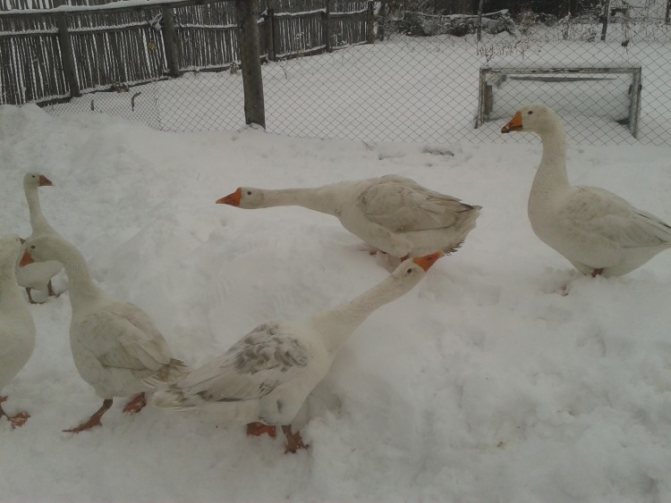

- Domestic goose - tips for beginners on the care and maintenance of poultry (video + 90 photos)
- Goose breeds are the most popular and productive breeds for breeding and rearing at home (115 photos and videos)
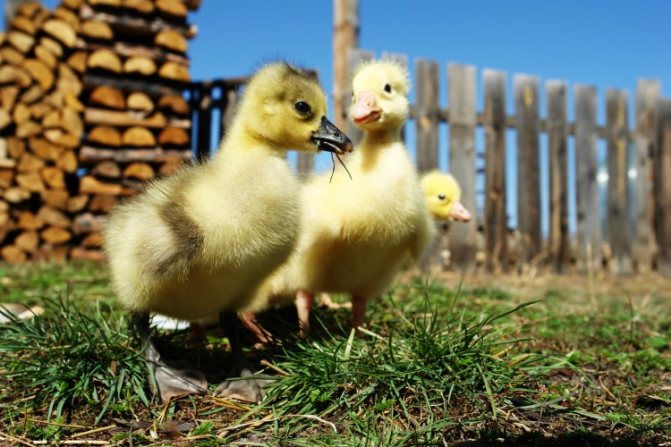

Treatment for goslings - the main types of diseases and their treatment at home. Recommendations of veterinarians for the prevention of diseases (115 photos + video)
Plucking free grass will protect chicks from various diseases. The only thing that needs to be done is to put special, small drinking bowls around the territory. In the presence of a female, the goslings will learn to survive on their own.
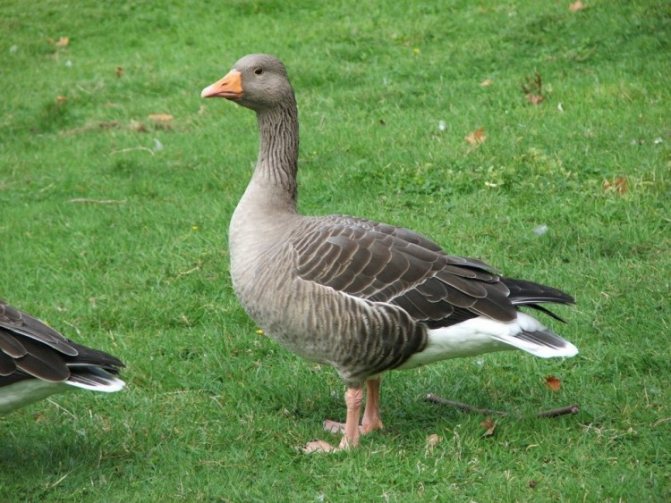

Poultry house arrangement
The main condition for the size of the birdhouse is that it should not be cramped. It is unacceptable to keep geese in cages, they must move. Be sure to provide free access to water and food. During the growing up of young animals, they are released into specially fenced pens in the open air. At night, the birds are in the poultry house.
Depending on the number of livestock, the correct room is selected. In the early days, chicks should be kept in cardboard boxes on the veranda or in the summer kitchen. Further, they must be assigned a place in the poultry house, where good ventilation is provided. It is required to insulate the barn, saving it from drafts and protecting it from the penetration of predatory animals, including rats.
It is recommended to use straw or chaff for bedding. Change the bedding every few days - it must be dry. This will protect weak chicks from hypothermia and various diseases. A prerequisite in the poultry house is the presence of windows. Geese like to be indoors only during the period when they sleep.
After the birds are 40 days old, they are grazed near the reservoir. But until the moment, until they get stronger, in order to defend themselves, a person must be present nearby. As soon as the birds gain at least 2 kilograms of weight, they can be sent to graze alone. Better to release them early in the morning. At this time, the herb is not only nutritious, but also very juicy.
Geese not only find food for themselves, but also orient themselves perfectly, therefore they will be able to find their way home on their own. Wings are clipped to birds so they will not fly away.
Disease prevention
Geese have excellent immunity, and in most cases the owner is to blame for diseases of the livestock or individual birds. Compliance with simple hygiene rules and special feeding will save the flock from possible problems:
- Before bringing new flocks into the house, they should be thoroughly cleaned and surfaces disinfected. For disinfection, you can use an affordable and inexpensive solution of caustic soda (2%). They also handle feeders, drinkers, and other equipment.
- Clean up the room in time, avoid heavy contamination of the litter. If it is already 25% wet, then pathogenic flora will develop in it.
- As for water, the geese, of course, love it. Drinking bowls and troughs for swimming in summer (if there is no reservoir) should be freely available. However, this bird is extremely susceptible to wet grass, so it is better not to let young animals out to pasture immediately after rain or if there is abundant dew on the plants, as this is fraught with bloating or enteritis.
- For the prevention of bacterial intestinal infections, goslings are given a special feeding:
- on the 11-12th day of the chick's life, K-5 kormogrizin is mixed into the compound feed at the rate of 4 g of the preparation per 10 kg of feed weight;
- on days 13-14, biovit-120 is given - 0.41 g / kg of live weight;
- for 15-20 days - paraform (2 g per 10 kg of compound feed).
Read more: Kholmogory geese breed description food content
Temperature and proper lighting
In the first 7 days of life, goslings need to adhere to a temperature regime in the region of 28-30 degrees. If the natural ambient temperature is not enough, they heat it with heating pads or lamps, which, in addition to light, heat the room. Temperature should be measured at litter level.


It is necessary to gradually lower the temperature to 22-24 degrees. And after the chicks are three weeks old, transfer them to the mode of life in natural conditions (if the weather permits). In general, adult geese are considered hardy birds, since they have a lot of fat, a lot of live weight and warm plumage. They can freely withstand temperatures down to -15 degrees. Indoor lighting should be sufficient to maintain normal conditions with extended daylight hours of more than 14 hours. For this it is important to use lamps.
Parent flock
In order to breed geese in the backyard using local incubation material, it is necessary to create a parent flock. The most effective individuals are chosen from the geese.
There can be 1-3 bird families in the courtyard. They are recommended to be kept in separate enclosures. There should be 4-5 females for 1 gander. A herd may consist of 15 geese and 2-3 ganders.
Igor Nikolaev
auto RU
Males begin to mature at 11 months. Sexual maturation in females occurs at 9 months. They start to lay eggs. For them, nests are installed in the aviary. Nest diameter 1.2 m; accommodate drawers with low walls, basins. They are covered with hay. 1 nest counts for 3 layers.
More on the topic: What breeds of large geese are there?
The air temperature in the house for adult geese is 18 C, humidity is 60%. At puberty, they begin to increase daylight hours to 16 hours. For fattening birds, light is turned on only during feeding. This will reduce their activity, which will affect the increase in body weight.
Males are kept separately. They begin to be brought to females from the age of 2. At this time, the bird's reproductive organs are developing well. The domestic goose is ready to mate. The geese begin to produce full-fledged eggs.
Mating is carried out 2-3 times a week. In large farms, artificial insemination is used. The method is more efficient. Fertility is 100%. With natural mating, the rate is no more than 60%.
Raising birds
If the chicks that have just been born have a weight of only 100 grams, then after 5 months their weight will reach 5-6 kilograms. On average, an animal gains more than 1 kilogram within a month. In order for the birds to be healthy and large, it is very important to carefully and carefully monitor their diet. Depending on the breed, the weight of adults varies in the range of 4.5-10 kilograms or more.
If the main purpose of breeding is to obtain meat, then it is better to keep the birds until they are 2-3 months old. During this period, they gain 50% of the mass of an adult one-year-old bird. Further, weight gain is inhibited.
So, it is very profitable to breed and keep these birds, since they not only grow quickly, but are also capable of producing large eggs, and you can also get high-quality fluff from them. But for the cultivation to be successful, you need to create all the necessary conditions for the birds. They should feel free and full.
0
Breed selection criteria
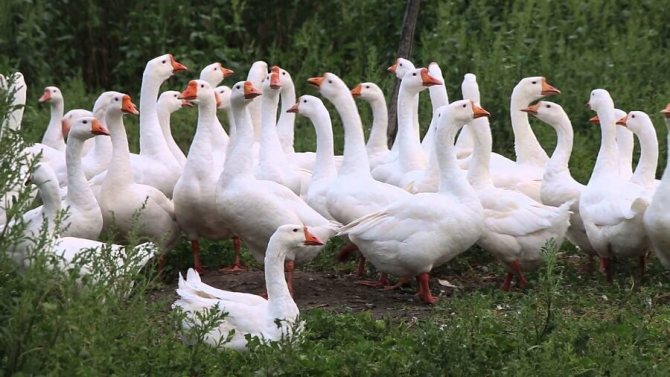

Goose breeds are quite diverse.
When breeding them, we took into account:
- Productivity, that is, the amount of meat obtained;
- Unpretentiousness;
- Disease resistance;
- Feather and down quality;
- Egg production;
For breeding geese at home, bird size and rapid growth are important.
Well-known domestic breeds include:
- Large gray. This variety is used to obtain meat, liver, eggs. Birds can do without a reservoir, they are fast growing. For 2 months, young goslings gain about 5 kg. The goose hatches eggs well, is attentive to chicks. She lays up to 20 eggs a year. The weight of an adult goose reaches 8 kg.
- The old Russian breed is the Kholmogory. Divorced for meat. Geese of this color are well acclimatized and are distinguished by longevity (live up to 17 years). The weight of an adult gander reaches 12 kg. The goose brings 30 eggs annually. Late puberty is considered a disadvantage of the breed.
- Toulouse geese they are distinguished by a calm disposition, they are not difficult to maintain. Impressive birds are large and very weighty. The gander will pull 10 kg, the female - 6 kg. Lays 30 eggs a year. The French goose can live without a body of water, but water is needed during breeding. The breed is prized for the quality of its meat and liver.
- Italian geese very beautiful, love warmth, need cleanliness and care. Meat and liver have a high taste. The goose lays up to 90 eggs per year.
Wintering room
Before the onset of cold weather, you should take care of a room for keeping geese in the winter, which is designed to protect them from dampness and wind. A general requirement for any room is wooden flooring.
An earthen or concrete floor is not suitable for delicate goose feet. Fits on the floor thick bedding from available material: peat, straw, sawdust. This will create comfortable conditions for keeping geese.
The use of artificial lighting in the premises until January-February speeds up the process of laying eggs and incubating chicks. The light should be turned on during daylight hours or 2-3 hours less. And in the future, the lighting can be left on. for 12 o'clock to ensure the correct process of hatching the offspring.
Equip a goose-house for the winter possible in different rooms.
Wooden shed
Any one available on the site is suitable for use. barn... It is also not difficult to specially build a house with your own hands from old boards. It is necessary to check the walls of the barn for gaps and seal them with straw or sealant.
Greenhouse
Vegetable greenhouses are idle in winter, so expedient use them for keeping poultry.
Polycarbonate greenhouses allow light to pass through and protect geese from drafts. The material is able to quickly heat up from sunlight or existing heating.
Before placing birds for wintering, it is necessary to clean the greenhouse of debris and dust and provide for the possibility of ventilation in the room.
Preparing the nests
Making a place for egg-laying yourself is very simple. To do this, you need thin boards with a thickness of 25 mm (if desired, they can be replaced with plywood). The size of the nest has the following parameters: 600x600x500 (length, width, height in mm). In the front part, a side is installed at a height of 100 mm It is needed in order to prevent bedding from spilling out.
The bottom of the nests is made of plywood or boards, but it is impractical to use metal.It is common for geese to bury the clutch to a great depth. The metal bottom will lead to the fact that the egg products will simply break and freeze when the cold weather sets in. When using plank floors in the nests, you do not need to make the bottom.


If we talk about how many nests are needed, then there is no consensus. According to practice, one place for laying is enough for several geese, but the scientific literature claims that each bird needs an individual place. It doesn't matter which option is chosen, the main thing is to take into account the separation of the nests with partitions. If geese are planned to be used as hens, then they will be assigned a separate room.
Poultry farmer on the spot. The quality indicators of eggs (taste or suitability for use in incubation) will be influenced by the humidity and cleanliness in the room. To maintain the highest quality, it is advisable to collect the egg products as soon as possible. To make it easier to determine the time of collection, it is worth considering that the geese rush at night or in the early hours. The litter in the nests should be changed regularly to prevent contamination of the eggshell.
Hunting features
Hunters know where to look for this shy waterfowl. Most often these are swampy areas overgrown with shrubs or reeds, surrounding a vast water surface. But here, as a rule, she is not hunted.
Gray geese come to feed on arable land, looking for last year's grain in the ground. They can also occupy a newly sown field and cause serious damage to the crop. Their gluttony can be judged by the killed specimens, stuffed with wheat so that it falls out even from the beak. During the day, the flock twice visits the feeding places (fields) and twice flies to the solder (to the swamps and lakes), and then flies away for the night.


The goose can be called a snob among other birds - it moves along the same airways and does not change its trajectory until someone scares it away. This habit increases the chances of hunters. It is almost impossible to sneak up on resting or grazing geese, since three or four long-necked gander constantly monitor what is happening around.
At the slightest suspicious movements or sounds, they raise the alarm, and the flock immediately soars into the sky. In addition, geese prefer to graze on small hills, away from ravines, forest islands and hay piles. Therefore, it is rather difficult to make an ambush at the feeding place.
It is much easier to trace the flight path, equip a skradok under it an hour before their appearance and wait quietly, trying not to move as much as possible. Even a slight movement will cause the geese to gain altitude or bypass the ambush. Sometimes it happens that they fly close to the hunter, but too far for a shot - at a distance of more than 100 meters.
Goose hunting is not an easy and very thankless business, which requires careful preparation and preliminary reconnaissance. Moreover, the flock flies high, and rarely descends to an acceptable 30 meters. In most cases, it passes at a height of a little more than fifty meters, and this is almost the limit of the range of the shot. By the way, it is better to take a fraction of 0, 00 or one.

